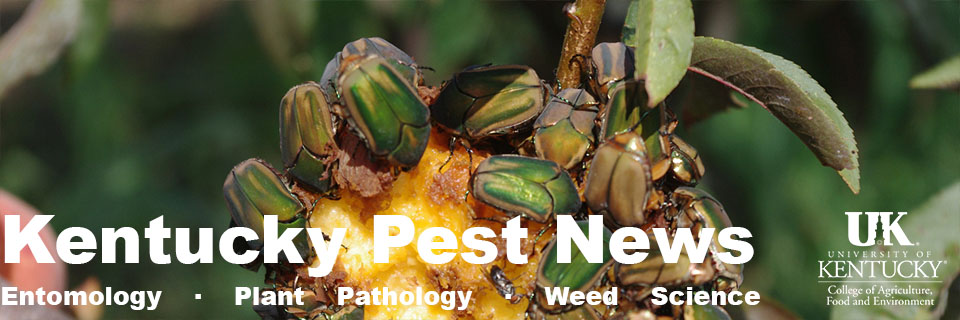Apple trees are approaching bloom and many pear are in full bloom, especially in southwestern Kentucky. Infection by the fire blight bacterium occurs during bloom, thus, protectant antibiotics should be applied when risk is high. Risk for infection can be…
Monthly Archives: March 2018
Eastern Tent Caterpillar Egg Hatch Begins
Larry Hanks, a certified arborist in central Kentucky, reported seeing newly hatched eastern tent caterpillars in Scott County on March 25. This is 7 to 10 days later than the typical mid-March date. Soon after hatch, the tiny caterpillars feed…
2018 Insect Trap Counts
Trap counts for major insect pests are provided by the Kentucky IPM Program. Traps are located at the UK Research and Education Center in western Kentucky and the UK Spindletop Farm in Lexington. Below are trap counts for the current…
2018 Insect Trap Counts
Trap counts for major insect pests are provided by the Kentucky IPM Program. Traps are located at the UK Research and Education Center in western Kentucky and the UK Spindletop Farm in Lexington. Below are trap counts for the current…
Alfalfa Weevils Are Hardy
The recent snow and cold should have little effect on developing alfalfa weevil populations. Temperatures must drop below minus 7o to minus 10o F to be lethal to eggs deposited in plant stems. Small larvae are killed by temperatures of…
Mite Management in High Tunnels
As the weather begins to warm, mite activity is likely to increase in high tunnels and greenhouses. Due to their small size and cryptic habits, it is usually easier to initially scout for signs of their activity, rather than trying…
Emerald Ash Borers 2018
Since the first discoveries of emerald ash borer in Boone, Jessamine, and Shelby counties in 2009, this invasive insect has spread through normal dispersal flights and the inadvertent movement of infested wood. Tunneling beneath the bark by the larvae (Figure…
Horn Fly: The $1 Billon Insect
Horn flies are important pests of pastured cattle (Figure 1). They use their piercing-sucking mouthparts to take about 30 blood meals every day. The almost incessant feeding of large populations can severely impact growing calves and lactating cows. Horn flies…
Collar Rot in the Tobacco Float System (PPFS-AG-T-03)
Collar rot can be found in tobacco float beds each year in Kentucky, causing a great deal of concern when it makes its appearance. Severe losses to this disease tend to be rare but can occur if care is not…
2018 Insect Trap Counts
Trap counts for major insect pests are provided by the Kentucky IPM Program. Traps are located at the UK Research and Education Center in western Kentucky and the UK Spindletop Farm in Lexington. Below are trap counts for the current…
Time for Eastern Tent Caterpillar Egg Hatch
After spending about 9 months as eggs in masses on twigs of wild cherry and related trees, the first few tiny eastern tent caterpillars (ETC) of the season should soon be leaving their eggs. The onset of the single generation…
Clover Mites Like Lush Lawns
Clover mites are accidental invaders that can be a temporary nuisance during early spring. These very small, reddish brown creatures appear only as moving dark spots to the naked eye. Sheer numbers, plus the resulting red-brown stain left behind if…
Worker Protection Standards Compliance
Agricultural pesticides have requirements on the label requiring various actions in order to protect the health of employees; these are the Worker Protection Standards (WPS). WPS requires owners and employers on agricultural establishments and commercial pesticide handling establishments to protect…
Managing Rhizoctonia Damping-off & Target Spot in the Float System (PPFS-AG-T-02)
Rhizoctonia damping-off and target spot occur each year in Kentucky tobacco transplant production. Once considered minor problems in float beds, both have increased steadily in importance in recent years, causing significant damage to seedlings. Sound management practices and early recognition…
Plant Disease Diagnostic Lab Highlights
The following plant disease highlights from the University of Kentucky Plant Disease Diagnostic Laboratories represent recent sample submissions from field crops, fruit, vegetables, and ornamentals. So far in 2018, diagnostic samples of agronomic crops have included secondary molds (“barn rot”)…
